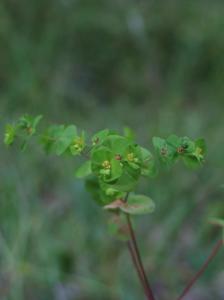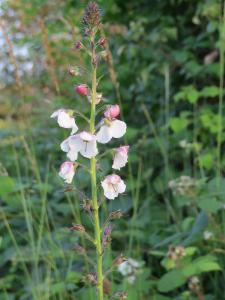Yesterday I paid a visit to Ravensnest Wood in the Wye Valley, to see one of the rarest plants found in this area, Upright Spurge (Euphorbia serratula). As a native species, Upright Spurge is found in Britain only in an area centred on the Wye Valley and the Forest of Dean. It is also naturalised in scattered locations, mainly in southern England. Although a rare plant in Britain, globally, it is found eastwards to central Asia.
 |
 |
Upright Spurge’s habitat is woodland on limestone, but not the dense dark parts: instead, it is found in the open, and does best on disturbed ground. Newly created forestry tracks and clearings are where it does best, particularly if limestone chippings are laid. Ravensnest wood held 500 plants in 1997, presumably when the access track there was very new. Yesterday I counted a much more modest 17 plants: along much of the track, grassland had become established, crowding the spurge out, and it was only present in areas where there was still very sparse vegetation. Here is a map of the location:
According to Sell and Murrell’s Flora of Great Britain and Ireland, the most authoritative reference work on Britain’s flowering plants, Upright Spurge occurs in only about 24 British localities. The densest concentration is around Tintern and so, predictably, it has acquired the local name “Tintern Spurge”. Other locations in the Wye Valley are spread throughout a 10km-long stretch from about Wynd Cliff in the south to around Whitebrook in the north. In the Forest of Dean, its main concentration is just to the west and north of Lydney. Much further east, it grows in Highnam Woods, just west of Gloucester. West of the Wye Valley, it occurs in Chepstow Park Wood and in Coed Wen Wood, east of Newport (note that the Grid Reference in Trevor Evans’ Flora of Monmouthshire for this last site is incorrect).
Seeds of Upright Spurge can lay dormant in the soil for years, possibly decades, and so if a site becomes overgrown, fresh disturbance can boost the population. At Highnam Woods, the RPSB does just that, using a rotavator, and so the population there is likely to be secure. At other sites, Upright Spurge has declined or even vanished, but could no doubt be encouraged to flower again if similar techniques were applied. How about it, Gwent and Gloucestershire Wildlife Trusts?





